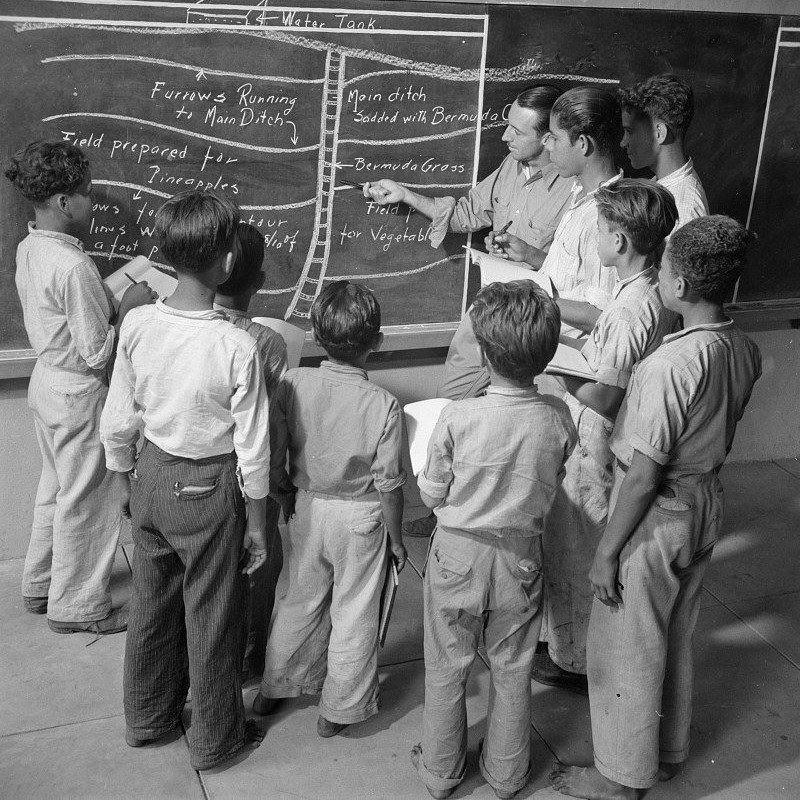
Puerto Rican Economy: American Commonwealth

Figure 1.--Here we see Puerto Rican students learming some of the basics of soil converstion during the Depression. The photograph was taken in 1938. Notice the lesson is in English. Puerto Rican schools were taught in Spanish with English taught as a foreign language. We suspect that a New Dealer was brought in from the states to teach modern farming methods. As a result of farm problems and the Dust Bowl, the New Deal made a major effort to address the problems of rural America.
|
|
Another major change occurred in Puerto Rico when the U.S. Army during the Spanish American War liberated the island from Spain (1898). This introduced American economic patterns and a much more robust economic partner. Puerto Rico became an American Commnwealth. American invetments helped to expand agricultural production, especially sugar production. Producion as a result increased dramtically. Sugar came to account for about 40 percent of the Island's cultivated land, 50 percent of agricultural labor, and more than 30 percent of the economic activity. Increases in sugar price brought a degree of prosperity to the Island. Puerto Rico became an important sugar producer. The Island was adversly affected by the Stock Market Crash leading to the Great Depression (1929). Commodity prices including sugar collapsed. Puerto Rico experienced devestating infrastructure and public health problems as a result of not only the the Depression, but the devastating San Felipe and San Ciprian hurricanes (1928 and 1932). The local political structure was uable to deal with it. Puerto Rico benefitted from the initial relief phase of the New Deal. A unique approach to Puerto Rico's problems was fashioned by the Puerto Rico Reconstruction Administration--PRRA (1935). The PRRA replaced all other New Deal activity on the island. It was a locally-run Federal agency. One assessment reports, "By building the island's first truly public works and establishing its first public authorities to administer them, the PRRA constructed a new public infrastructure capable of addressing three interrelated goals: increasing life expectancy through concrete interventions in public health; providing more egalitarian public access to a safer and more permanent built environment; and limiting the private corporate control of Puerto Rico's natural resources. Designed by Puerto Rican engineers and built by Puerto Rican workers, PRRA public works projects made concrete contributions to the physical security of millions of Puerto Ricans through the construction of hurricane-proof houses, schools, hospitals, roads, sewers, waterworks, and rural electrification networks." [Burrows] Special laws were passed after World War II to promote economic development on the Island.
Political leaders in the Third World were convinced that prosperity required industrialization. Puerto Rican leaders were no exceotion. The goal was to develop a manufacturing sector. The Puerto Rican program to promote industry was Operation Bootstrap. The plan was to industrialized by using local labor, draw foreign capital (mostly American), import raw materials, and export finished product (mostly to the United States).
A major part of Operation Boostrap was to attract American corporations by offering tax breaks. The econony began to shift from agriculture to manufacturing. Tourism also became important. The result was to make Puerto Rico the most wealthy island in the Caribbean other than small islands like the Caymans with tax have banking industries. Income levels, however, remained far below those in the mainland United States.
Sources
Burrows, Geoff G. "The New Deal in Puerto Rico: Public Works, Public Health, and the Puerto Rico Reconstruction Administration, 1935-1955" (2014). CUNY Academic Works. PhD dissertation. This is a good description of the PRRA and the author accurately describes the accomplishments of the New Deal effort. What he does not address in general did not address was how to turn ab economy still affected by the Spanish colonial era into a modern capitalist system. This in fact mirrors the New Deal although the issue with Americn in general is reinvigorating the existing capitalist economy. And here the New Deal did very poorly with many importabt New Dealers actually questioning capitalism. Part of the problenm in fairness was the hostility of industry/business to eben moderate reform. The bitterness of this debate is probably a factor in wgy the Depression persisted so long in America.
HBC

Navigate the Boys' Historical Clothing Web Site:
[Return to the Main Puerto Rico economy page]
[Return to the Main Puerto Rico page]
[Return to the Main country economies page]
[Introduction]
[Activities]
[Biographies]
[Chronology]
[Cloth and textiles]
[Clothing styles]
[Countries]
[Topics]
[Bibliographies]
[Contributions]
[FAQs]
[Glossaries]
[Images]
[Images]
[Links]
[Registration]
[Tools]
[Boys' Clothing Home]
Navigate the Boys' Historical Clothing Web Site:
[Return to main country page]
[Australia]
[Canada]
[England]
[France]
[Germany]
[Ireland]
[Italy]
[New Zealand]
[Scotland]
[Spain]
[United States]
Crerated: 12:34 PM 2/27/2018
Last updated: 12:34 PM 2/27/2018



